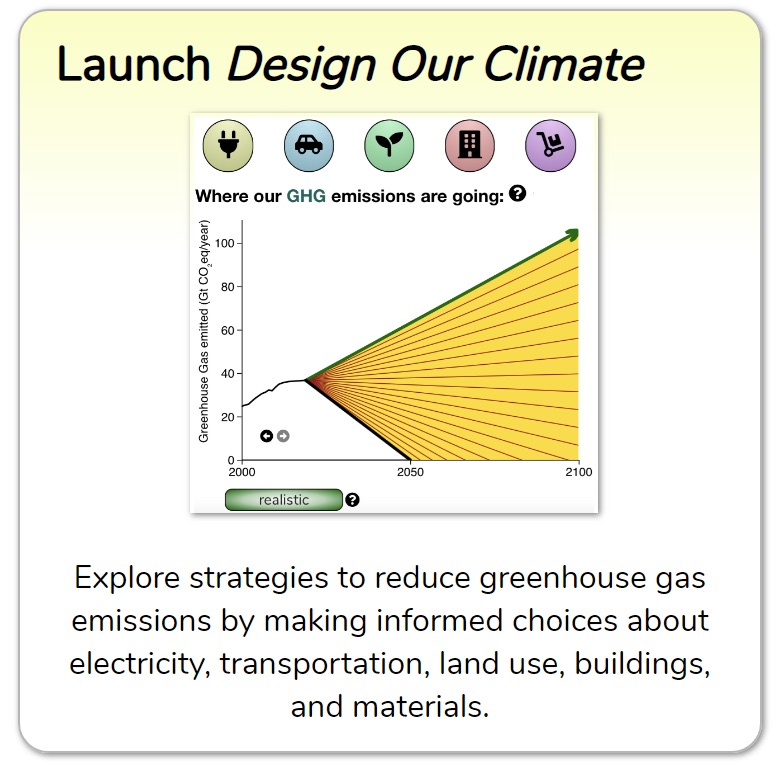How do we move from feeling paralyzed by polarized politics toward meaningful action on an issue as overwhelming as climate change?
This is the question at the heart of a new tool developed by a team of chemistry and physics professors and undergraduate students at a research centre of the King’s University in Edmonton.
Peter Mahaffy, the director of the King’s Centre for Visualization in Science, thinks the team from the oil capital of Canada is well situated to address such large existential issues.
“If these conversations about energy efficiency and climate can happen in Alberta, they can happen anywhere in the world,” Mahaffy said.
He acknowledges these conversations in Alberta are “extremely polarizing,” but believes the gaps can be breached by thoughtful and intentional communication that encourages people to see how they can be a part of the solution.
Design Our Climate, known as DOCs, is an interactive simulation supported by Energy Efficiency Alberta, a provincial government-funded program. The tool is peer-reviewed by 25 global experts on a variety of intersecting fields including climate change, mitigation strategies and impacts and education.
The tool takes the complicated challenge of climate change and breaks it down into “wedges” that are more manageable.
Users can use the tool for free through the KCVS website on a laptop or desktop.

Users can see where global greenhouse gas emissions are headed if we continue our current trajectory of exponential increase, and they can see where we need to go if we’re to hit “net-zero” emissions by 2050.
They can design their own climate future by customizing mitigation strategies through adjusting multiple variables from five different sectors: electricity, transportation, land use, buildings and materials.
Each sector breaks down into sub-categories to reveal more specific information about how some variables are more carbon-intensive than others. For example, coal power and natural gas are more carbon-intensive than solar, wind and nuclear. The DOCs tool provides feedback as the user adjusts the variables, flagging a “reality check” message when they’ve veered into territory that isn’t realistic or has alternative costs. For example, move the solar energy meter too high and the tool will alert you that solar energy requires a certain amount of land for solar panel deployment.
“There’s no silver bullet to get from where we are to where we need to be,” Mahaffy said. “We’re not going to do it all with wind, not just with solar, but maybe we can get to where we need to be with a silver buckshot — a mosaic of solutions.”
Once the user finishes changing the different variables to lower global GHG emissions, they can move towards “what’s next” and create their own action plan. People are invited to share the resource with friends, family, colleagues and even their elected officials.
The hope, Mahaffy said, is “to get people engaged in deep and meaningful conversations about climate change solutions.”
DOCs uses an approach, introduced at Princeton University 15 years ago, that addressed the seemingly insurmountable problem of greenhouse gas emissions by breaking it into smaller, more tangible challenges. Mahaffy found the approach to be a hopeful one when the King’s group was feeling discouraged and overwhelmed after years of working on providing digestible information on climate science.
The team drew on research about the best ways to engage people about climate change, and they are hopeful the tool will help people navigate past polarizing viewpoints. “We frame the language, the conversation, to get at the things the audience care about and communicate with trusted messengers,” he said.
Mahaffy said environmental advocates and educators around the world have shown interest in the tool, as has the Chemical Institute of Canada, a professional association that includes people who work in the fossil fuel sector.
The team hopes the tool will be used in a variety of contexts as a depolarizing conversation starter about solutions to the climate crisis. The team is working with three partner organizations to distribute the tool.
The Alberta Council for Environmental Education, a charity working to advance environmental education in the province, is working on getting the simulation into the province’s Grades 9 and 10 science and social studies classrooms. Staff at Student Energy, a non-profit that distributes energy information to students globally, are distributing it to university students. And Energy Futures Lab, an Alberta-based think tank, is using the tool with their public outreach and industry education.
Last weekend the King’s team launched the simulation at the Alberta Teachers’ Association science council conference where Mahaffy said it was well-received.
“My sense is that Canada is ready for non-polarizing conversations about climate change,” he said. ![]()
Read more: Energy, Education, Environment
















Tyee Commenting Guidelines
Comments that violate guidelines risk being deleted, and violations may result in a temporary or permanent user ban. Maintain the spirit of good conversation to stay in the discussion.
*Please note The Tyee is not a forum for spreading misinformation about COVID-19, denying its existence or minimizing its risk to public health.
Do:
Do not: